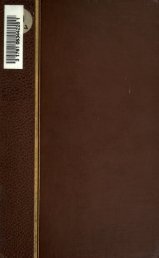jahrbuch numismatik geldgeschichte - Medievalcoinage.com
jahrbuch numismatik geldgeschichte - Medievalcoinage.com
jahrbuch numismatik geldgeschichte - Medievalcoinage.com
Sie wollen auch ein ePaper? Erhöhen Sie die Reichweite Ihrer Titel.
YUMPU macht aus Druck-PDFs automatisch weboptimierte ePaper, die Google liebt.
More on the Prague Type 97<br />
ved from it (weight 1.44 grams). Nos. 18-19 certainly form a separate<br />
group (1.72 and 1.20 grams); I am not aware of derivatives from<br />
it. I have not <strong>com</strong>e across evidence in the collections where these coins<br />
are kept (B. N. Paris, the Hague Cabinet, the Vienna Cabinet, the Hunterian<br />
Museum, Glasgow, and a private British collection) pointing to<br />
the original home of any of these six coins 4.<br />
In practice, nonetheless, it is fairly safe to assume that both series of<br />
prototypes had their home in the region between the Elbe, the Rhine<br />
and the Alps. This is confirmed to some extent by such little information<br />
as we have on both the origin of the types and their influence on<br />
other Celtic coinages.<br />
The head of Apollo with flowing hair and laurel wreath is such a<br />
<strong>com</strong>mon classical type that no attempt can be made to pin down the<br />
exact model of the prototype coins. Oddly enough, there is no such<br />
head on Roman denarii; for a Roman model one would need to go<br />
back to Romano-Campanian didrachms (Sydenham Nos. 4-5). But<br />
the type is one of many used at Massalia and it was early adopted on<br />
Celtic silver coins of Dauphine and Savoie. The principal types are<br />
those with the legend IANVS in Italiot characters (B. N. Paris 2901-<br />
11, weight 2.30-2.20 grams), those with the legend VOL in Roman<br />
characters (B. N. Paris 2621-44, 2893-5, weight 2.45-2.30 grams),<br />
and those where the horse is replaced by a chamois (B. N. Paris 2878<br />
—92, weight 2.40-2.30 grams). The same head occurs on the silver<br />
(and later bronze), coins of Avenio (B. N. Paris 2509-14, weight 2.40<br />
—2.20 grams). All these are probably coins of the second century B.<br />
C., and all are heavier than the Prague type prototypes. The likelihood<br />
is, therefore, that we should look to the west or south west for the<br />
origin of the head on the prototypes.<br />
lt is eot equally easy to point to an origin for the horse on the reverse<br />
of these coins, since on small silver coins the use of a horse is<br />
so widely spread. The most characteristic and enduring feature is the<br />
treatment of the raised and bent forelegs of the horse. This is seen on<br />
many tetradrachms of Danubian origin. There are also Danubian parallels<br />
for the severed head of no. 2, though parallels are not confined<br />
to that region. One may suspect that many of the small silver coins of<br />
the German area have a mixed origin, partly from the west and partly<br />
7<br />
4 Since this was written, I have <strong>com</strong>e across four more specimens, as follows, two<br />
of which have find-spots:<br />
(a) Similar to nos. 14-15: Mainz, RGZM Co]lection, no. 0 25668.<br />
(b) Similar to nos. 14-15: found at Bucher Forst, Ldkr. Uffenheim, Bavaria; Jahrbuch<br />
des Bernischen Historischen Museums in Bern XLI/II (1961-2), 270 (a).<br />
(c) Similar to no. 16: found at Jüchsen, Kr. Meiningen, Bez. Suhl, Flur Widderstadt;<br />
Ausgrabungen und Funde 11, 1966, 257 no. 19.<br />
(d) Similar to nos. 18-19: Karlsruhe, Badisches Landesmuseum.

















